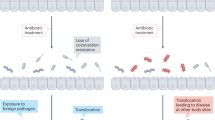Summary
An outline is given of the various host-related and flora-related parts of the colonization resistance of the digestive tract. The host-related part of the colonization resistance has been found to be somewhat decreased by sublethal irradiation and leukemia (or chemotherapy), while treatment with antibiotics active against gram-positive flora may severely decrease the colonization resistance (depending on the antibiotic concentration established within the digestive tract during antibiotic therapy). The flora-related part of the colonization resistance, which controls colonization by potentially pathogenic microorganisms, differs greatly from one individual to the next. This observation appears to be important for the host-related part of the colonization resistance. Finally, it is concluded that in the clinical situation preference should be given to antibiotics which do not affect the part of the flora constituting colonization resistance for two reasons: 1) to limit the spread of (multi-) resistant potentially pathogenic microorganisms and 2) for infection prophylaxis in immunocompromised patients. In the latter situation, the potentially pathogenic microorganisms in the flora are selectively eliminated from the digestive tract, provided the antimicrobial drugs used for selective decontamination are active against the endogenous potentially pathogenic microorganisms and given in sufficient (oral) doses.
Zusammenfassung
Die verschiedenen Faktoren von seiten des Wirts und der Darmflora, die an der Kolonisationsresistenz des Verdauungstrakts beteiligt sind, werden dargestellt. Es hat sich gezeigt, daß der Beitrag des Wirtsorganismus zur Kolonisationsresistenz durch Bestrahlung mit subletalen Dosen und Leukämie (oder Chemotherapie) bis zu einem gewissen Grad vermindert wird. Die Behandlung mit Antibiotika, die gegen grampositive Keime der Darmflora wirken (abhängig von der im Verdauungstrakt unter der Therapie erreichten Konzentration) kann die Kolonisationsresistenz hingegen erheblich beeinträchtigen. Der Anteil der Darmflora, der die Kolonisationsresistenz darstellt und eine Kontrollfunktion bei der Besiedelung mit potentiell pathogenen Mikroorganismen ausübt, unterliegt starken interindividuellen Schwankungen. Diese Beobachtung scheint für den Beitrag des Wirtsorganismus zur Kolonisationsresistenz von Bedeutung zu sein. Wir kommen zu der Schlußfolgerung, daß aus zwei Gründen in der Klinik Antibiotika bevorzugt werden sollten, die keinen Einfluß auf den Anteil der Darmflora ausüben, der die Kolonisationsresistenz darstellt. 1. Um die Ausbreitung (multi-) resistenter, potentiell pathogener Mikroorganismen einzuschränken und 2. zur Infektionsprophylaxe bei Patienten mit beeinträchtigter Immunabwehr. Bei letzteren wird der Anteil der potentiell pathogenen Mikroorganismen der Darmflora selektiv aus dem Verdauungstrakt eliminiert, wenn eine selektive, orale Dekontamination mit gegen endogene, potentiell pathogene Mikroorganismen wirksamen Substanzen in ausreichender Dosierung durchgeführt wird.
Similar content being viewed by others
Literature
Eickhoff, T. C. Nosocomial respiratory tract infections: the gastrointestinal tract as a reservoir. In:van der Waaij, D., Verhoef, J. (eds.): New criteria for antimicrobial therapy: maintenance of digestive tract colonization resistance. Excerpta Medica, Amsterdam, Oxford 1979, pp. 5–11.
Lincoln, K., Lidin-Janson, G., Winberg, J. Resistant urinary infections as a consequence of changes in the resistance pattern of fecal flora induced by antibiotics and hospital environment. Br. J. Med. 1 (1970) 305–309.
van der Waaij, D. Colonization resistance of the digestive tract: clinical consequences and implications J. Antimicrob. Chemother. 10 (1982) 263–270.
van der Waaij, D., Berghuis-de Vries, J. M., Lekkerkerk-van der Wees, J. E. C. Colonization resistance of the digestive tract and spread of bacteria to lymphatic organs in mice. J. Hyg. (Camb.) 70 (1972) 335–342.
van der Waaij, D. The colonization resistance of the digestive tract in man and animals. Zbl. Bakt. Suppl. 7 (1979) 155–161.
Sprunt, K., Redman, W. Evidence suggesting importance of role of interbacterial inhibition in maintaining balance of normal flora. Ann. Intern. Med. 68 (1968) 579–590.
van der Waaij, D., Berghuis, J. M. Determination of the colonization resistance of the digestive tract of individual mice. J. Hyg. (Camb.) 72 (1974) 379–387.
Cooke, E. M., Hettiaratchy, G. T., Buck, A. C. Fate of ingestedEscherichia coli in normal persons. J. Med. Microbiol. 5 (1972) 361–369.
van der Waaij, D. The digestive tract in immunocompromised patients: importance of maintaining its resistance to colonization, especially in hospital inpatients and in those taking antibiotics. In:Sabath, L. D. (ed.): Action of antibiotics in patients. Hans Huber Publishers, Bern, Stuttgart, Vienna 1982, pp. 104–118.
van der Waaij, D. Colonization resistance of the digestive tract as a major lead in the selection of antibiotics for therapy. In:van der Waaij, D., Verhoef, J. (eds.): New criteria for antimicrobial therapy: maintenance of digestive tract colonization resistance. Excerpta Medica, Amsterdam, Oxford 1979, pp. 271–280.
van der Waaij, D., Berghuis-de Vries, J. M. Selective elimination ofEnterobacteriaceae species from the digestive tract in mice and monkeys. J. Hyg. (Camb.) 72 (1974) 205–211.
Sleijfer, D. Th., Mulder, N. H., de Vries-Hospers, H. G., Fidler, V., Nieweg, H. O., van der Waaij, D., van Saene, H. K. F. Infection prevention in granulocytopenic patients by selective decontamination of the digestive tract. Eur. J. Cancer. 16 (1981) 859–869.
Guiot, H. F. L., van der Meer, J. W. M., van Furth, R. Selective antimicrobial modulation of human microbial flora: infection prevention in patients with decreased host defense mechanisms by selective elimination of potentially pathogenic bacteria. J. Infect. Dis. 143 (1981) 644–654.
Dekker, A. W., Rozenberg-Arska, M., Sixma, J. J., Verhoef, J. Prevention of infection by co-trimoxazole in patients with acute non-lymphocytic leukemia. Ann. Intern. Med. 95 (1982) 555–559.
Kurrle, E. Infektprophylaxe bei der Induktions-Therapie akuter Leukämien. Klin. Wochenschr. 59 (1981) 1085–1089.
Author information
Authors and Affiliations
Rights and permissions
About this article
Cite this article
van der Waaij, D. Colonization pattern of the digestive tract by potentially pathogenic microorganisms: Colonization-controlling mechanisms and consequences for antibiotic treatment. Infection 11 (Suppl 2), S90–S92 (1983). https://doi.org/10.1007/BF01645295
Issue Date:
DOI: https://doi.org/10.1007/BF01645295




